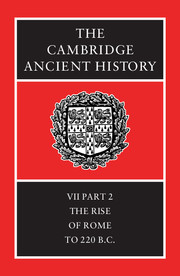
- Cited by 1
-
Cited byCrossref Citations
This Book has been cited by the following publications. This list is generated based on data provided by Crossref.
Brock, Andrea L. Motta, Laura and Terrenato, Nicola 2021. On the Banks of the Tiber: Opportunity and Transformation in Early Rome. Journal of Roman Studies, Vol. 111, Issue. , p. 1.
- Publisher:
- Cambridge University Press
- Online publication date:
- March 2008
- Print publication year:
- 1990
- Online ISBN:
- 9781139054355
- Subjects:
- Ancient History, Classical Studies
- Collection:
- Cambridge Histories - Ancient History & Classics
- Series:
- The Cambridge Ancient History




